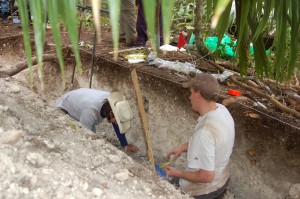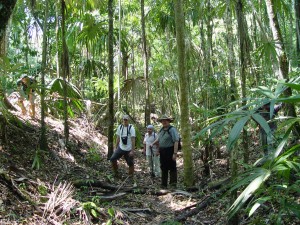BYU-led research expeditions into Guatemala and Mexico have unearthed more questions about how the ancient Maya flourished in the harsh jungle environments of Central America.

While the predominant question in popular culture is what happened to the Mayas, the question on the mind of BYU plant and wildlife professor Richard Terry’s was how the people lived.
“The ancient people were wealthier than the modern people living there, and their populations were larger. How did they have time to build it all?” Terry said.
The geography of Tikal includes rainforest-covered hills that descend into lowlands known as “bajos.” Anthropologists have traditionally believed the Maya grew the majority of their staple maize crops on the fertile hillsides.
Soil analysis by Terry proved that corn was not extensively grown on the hill, but had been grown in the lowlands by the Maya for hundreds of years.
For the past 15 years, Terry has been leading teams of students and researchers from BYU and other universities into countries in Central America to analyze the soil at various Maya ruins, using new technologies for soil analysis, remote sensing and satellite imaging. He travels to different geographical areas to learn as much about the different Maya communities as possible.
“Dr. Terry is always looking for new sites to sample and new archaeologists to work with so we took some time to visit many other sites. In the two weeks I think we visited 22 different archaeological sites,” said Tayte Campell, an environmental science student who assisted Terry on his expedition to Yucatan, Mexico.
While Tikal is a forested area with wetlands that flood in the rainy season, Yucatan is less fertile.
“When I think of jungle, I think of deep, rich soils that are good for farming, but it seemed like where we were at in the Yucatan just wasn’t the case. This makes the mystery of where and how the Maya grew their sustenance even more intriguing,” said Ben Hawkins, an undergraduate environmental science student who accompanied Terry on the Yucatan expedition.
To discover where the crops were grown, researchers test the soil around the cities for traces of carbon, which indicates that the land was used to grow maize.
In Tikal, students gathered 800 soil samples from different locations, including the hill slopes and the lowlands. Gathering the samples is just the beginning, however, as no conclusions can be drawn until the soil is analyzed extensively in the lab.
“I am currently in the process of sorting, drying, grinding and eventually processing the samples we took in the Yucatan and eventually we will run tests on the soils and see exactly what these soils were used for when the ancient Maya were thriving,” Hawkins said.

Further trips will need to be made before the team offers a conclusive statement on Maya agricultural practices.
“The agricultural potential of the vast bajos surrounding Tikal remains unknown. Once we have soil data from the bajos surrounding Tikal, we can expand this study to a much larger extent of Tikal’s sustaining area,” wrote Terry and graduate student Chris Balzotti in the research report of the trip.
The agricultural system the researchers are discovering is evidence of a powerful civilization that used the land to its best advantage. Further expeditions into the wetlands in Tikal will reveal how much land was dedicated to agriculture, thus showing how many people could be sustained in the location. The analysis of the soil at ancient sites is essential to building a picture of how the Maya lived.
Hawkins expressed gratitude to Professor Terry and the university for the chance to go on the expedition.
“I will never forget this,” he said. “It was a once in a lifetime experience to be able to visit all of these places and learn all the while from Dr. Terry and the locals about ancient Maya civilization and daily life.”
Although information about the Maya has already been discovered, deeper investigations are necessary to reveal more about the lifestyle of the ancient people. At the moment, Terry can’t offer a definitive statement on how the Maya civilizations functioned in an economic and social sense, but with each discovery scientists begin to develop a greater understanding of how they lived.
Further investigations will hopefully reveal the size of the Maya empires and how they managed to build a thriving civilization before they diminished and disappeared.
“We don’t have the answer yet, but we’re getting there,” Terry says.




